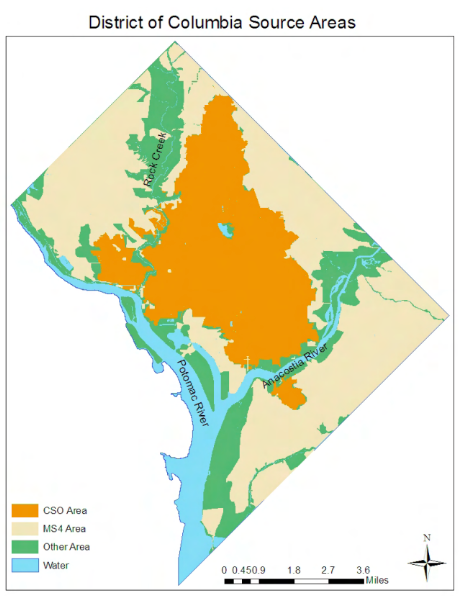Executive Summary: Rainstorms cause flooding and damage properties in areas with high densities of impermeable surfaces in DC. Much of our infrastructure also combines stormwater with sewage, which overflows in our rivers during storms. Stormwater fees are used to help DC avoid this. Clients ask us if Honeydew offers help in controlling DC’s increasing stormwater costs, and we do! Contact Andrew at az(at)honeydewadvisors.com for advice on implementing infrastructure that will reduce operating costs and increase property value.
Acronyms and Initialisms In the Stormwater World
CSS: Combined Sewer System. Combines sewage with stormwater.
CSO: Combined System Overflow. When sewage exceeds the capacity of a CSS and enters the watershed.
MS4: Municipal Separate Stormwater System. Keeps sewage separate from stormwater.
DOEE: DC’s Office of Energy and Environment who administers the stormwater program
ERU: Equivalent Residential Unit. Equal to 1,000 sqft of impermeable surface area
CRIAC: Clean Rivers Impervious Area Charge. Fee that DC Water assesses based property’s ERUs. Currently $20.94/ERU/month. No way to mitigate this fee.
DC SW: DC Government StormWater Fee. Also based on ERUs- $2.67/ERU/Month. This fee CAN be reduced through infrastructure improvements
SRC: Stormwater Retention Credit is granted by DOEE for each gallon of rainwater stored on site for a year. They offer a variety of incentive programs for property owners to voluntarily retain stormwater their property. Current trading offers a return of $1.80/gallon/year.
Until recently, water expenses were significantly lower than electric and natural gas, especially on commercial properties. However, potable water rates have increased at a higher pace than other utilities in the past 20 years. The District of Columbia and DC Water have been national leaders in providing incentives, and regulatory requirements to address some of the challenges outlined above. They started charging property owners fees based on the square footage of impermeable surface area on their properties many years ago as they saw the existing stormwater management systems failing and started planning for the future.
After looking at your steep bill from DC Water, you may be thinking, “So, why would the City care about stormwater? It’s not my fault that storms happen!” We’ll get to the why shortly, but let’s first take a wider perspective on the urban water cycle. Stormwater generally ends up in three places: 1. Soaked into the ground 2. Stored on site or 3. Into the municipal sewer system. If it soaks into the ground, or can be stored and used for landscaping or cooling air towers, it can sustain plants and is “infiltrated” and purified through the soil into groundwater. This water is relatively clean and has been undergoing this natural process for eons.
Sewer systems are much younger, dating back to cities in Ancient Mesopotamia as early as 4000 B.C. These ancient systems were remarkably similar to today’s sewers: they had water flushed latrines with underground clay pipes that carried water to a cesspit, which served the same function of today’s septic tanks. Had the Mesopotomanians simply abided by the aphorism, “Don’t shit where you eat” such innovation may have been delayed by centuries!
So what’s changed since 4000 B.C.? A couple things. Namely: 1. Cities are much bigger and 2. They are covered in concrete and asphalt surfaces. Such impermeable surfaces carry stormwater into the sewer system. Sewers were primarily designed to carry sewage (blackwater) away to be cleaned so it can reenter the natural water cycle without polluting our watershed. Stormwater and non-fecally contaminated wastewater (greywater) do not require the same level of decontamination. Hence efficient sewer systems should keep graywater separate from blackwater to reduce operating costs. These systems are referred to by the EPA as Municipal Separate Storm Sewer Systems or MS4.
Unfortunately, one third of DC’s sewer system is a Combined Sewer System, or CSS, which mixes all wastewater together. The sewers can only hold so much water and their capacity has not kept pace with the increased amount of impermeable surfaces in the District. During periods of heavy rain, the system can overflow into our rivers and groundwater. DC Water refers to this as Combined System Overflow (CSO). While not as detrimental, MS4 greywater overflows also contain many pollutants that should be kept out of our watershed. Check out the map above to see the different sewer systems in DC. DC Water’s goal is to reduce CSOs by 96% by 2025.
Increasing storm sizes and durations suggest now is the time to implement voluntary stormwater management improvements to your property. An ounce of prevention is worth a pound of cure when it comes to stormwater. Improperly irrigated land results in structural damage to buildings and can create emergency flood situations.
DC’s Office of Energy and Environment (DOEE) and DC Water have adopted a carrot and stick approach to remedying these issues. The stick comes in the form of intelligent regulations for new development or redevelopment and impervious surface / stormwater fees. These are referred to as the Clean Rivers Impervious Area Charge (CRIAC) and DC Government StormWater (DC SW) fees. Both are based on the total area of impervious surface on the property, which is measured in Equivalent Residential Units (ERUs) or 1000 sqft.
The CRIAC fee is $20.94 per ERU per month. These fees are used to pay for large scale stormwater mitigation projects across the city. Unfortunately there is no way for an individual property owner to lower this cost, beyond owning less property.
The DC SW fee is $2.67 per ERU per month, having increased by 115% since their introduction in 2009; an average of 7% annual inflation. It’s this fee that you can reduce or eliminate by improving your property’s infrastructure.
DOEE offers several carrots through their RiverSmart and Stormwater Retention Credit (SRC) systems. A property can generate SRC’s in one of two ways: 1. Implement approved stormwater mitigation measures or 2. Purchase stormwater credits to offset your stormwater impact. Additionally, DOEE is offering to purchase SRCs from property owners who implement measures that exceed their current stormwater responsibilities. Unlike SW fees, the SRC market has remained relatively stable since it’s introduction in 2014. Stormwater Credits are currently trading at around $1.80 gallon of stormwater retained or used per year for both MS4 and CSS areas. These prices can be locked in at different rates over 3 or 6 years through DOEE.
We’ve been working with Michael Lucy @ Sustainable Life Designs to help our clients understand regulatory requirements and implement landscaping and green infrastructure improvements for their properties. Michael’s strategic approach allows, “landscape improvements to put money in your pocket, enhance safety, aesthetics, provide social benefits to the community, and significantly improve the local environment. Hiring an experienced, integrated team is essential to achieve these goals.”
So how can you mitigate your stormwater impact? One of the least expensive ways is to channel rain water directly into a permeable space on your property. The amount of land will have to be approximately 10% the size of the impermeable surface draining to it for significant. For example, if you have a 10,000 sqft roof, you could direct the water onto a 1,000 sqft patch of soil. Given how tight real estate is in DC, it’s likely that you may not have this luxury. In this case, consider implementing other measures:
- Cisterns: Cisterns work according to the same principles as rain barrels, except these are typically installed underground. MOVE UP TO #1?
- Commercial Scale Rain Barrels: Rain barrels siphon stormwater out of gutter systems or impervious surfaces and store it in the barrel. The water can then be used for watering plants, cleaning off sidewalks, or flushing toilets.
- Green Roofs: This sophisticated improvement protects the roof membrane and uses engineered soil and plants. While it is possible to plant vegetables and flowers to enhance the amenities of a roof, most roof owners opt for low maintenance plants like succulents. DOEE offers a rebate equal to $10 to $25 per sqft for those who voluntarily want to install a green roof. However, owners should work with licensed professional structural engineers to ensure their building can handle the additional weightload of all that soil and retained water.
- Bioretention Rain Gardens: These gardens use sandy soils, native shrubs, perennials, and flowers planted in a shallow recession. The benefits of such gardens are three fold. Firstly, they can retain 30% more water than lawns. Secondly, they filter out 80 – 90% more nutrients from stormwater before it becomes groundwater. And finally, they look beautiful and increase property value.
- Plant trees in good soil to capture water and receive clean air and cool shade.
- Solar Canopy Gutter Systems: Gutters can be rigged to both roof mounted and ground mounted solar canopies to channel water away from the sewer system, into your landscape and increase your property values.
If you would like more information about any of these measures, please reach out to Andrew at az(at)honeydewadvisors.com. Also check out references for this article below for more information.
https://en.wikipedia.org/wiki/History_of_water_supply_and_sanitation
https://www.dcwater.com/sewer-system-improvements

